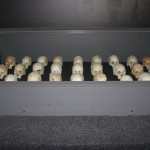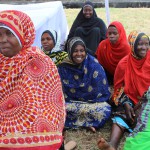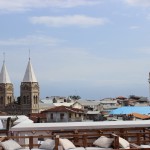Africa with Clinton: Rwanda / South Africa (Day 8)
 Early call time: luggage in the lobby by 7am. Departure from hotel at 7:45am. These early mornings are killing me. But thanks to some medication, the back pain subsided enough that I was able to sleep through the night.
Early call time: luggage in the lobby by 7am. Departure from hotel at 7:45am. These early mornings are killing me. But thanks to some medication, the back pain subsided enough that I was able to sleep through the night.
Had breakfast with Dawn today. We agreed that we are both ready to go home. I’ve only been on the road since last week, but Dawn’s been on the road since July 21 — she joined this trip straight from a basketball recruiting trip to Lithuania. My new friend, Linda Johnson Rice (publisher of Ebony Magazine), has been on the road since July 25 — she was in Greece before this trip. We’re agreed — it’s been nice, but it’s time to wrap this up …
Kigali Genocide Museum
First stop this morning: the Kigali Genocide Museum. This museum tells the story of the genocide that occurred in Rwanda (pronounced Rhonda) in the early 1990s. More than one million people were killed in the ethnic violence that raged in the country. It was Hutus versus Tutsis, with the Tutsis being the underdogs. While the world watched, a million people were killed, even though the international community had much advance notice that massacres were being planned.
Here’s the irony: prior to the arrival of the colonial powers in the early 1900s, the Rwandan people has been all one ethnic group. But the colonialists, in an effort to divide and conquer, created artificial divisions among the people based on economic stratification. All Rwandans had to obtain an identity card, and Rwandans who owned more than ten cows were labeled Tutsi, and those with less than ten cows were Hutus. Because of this, it was very possible to have a Hutu and a Tutsi in the same family. Tutsis, because of their economic status, were considered superior to Hutus, and were given better jobs and more opportunities for advancement. Over time, Hutu resentment grew against Tutsis, and soon after the colonial powers were finally forced out of the country, a Hutu took power and began to plan the genocide of Tutsis.
Weapons were stockpiled and on a planned, specific date, the massacres began. Hundreds of thousands of Tutsis — men, women, and children, were beaten, maimed, tortured, and killed. Women were raped in front of their husbands and/or children. Entire families were wiped out. Parents were made to kill their children, and children were made to kill their parents. Brutal.
Outside the museum, there are fourteen mass gravesites, each one holding the remains of thousands of the dead. Inside there are exhibits explaining the history of the conflict, how the massacre was planned, the role of the international community, and how they are now rebuilding their nation. Two exhibits were particularly moving: one was the “Childrens’ Room” which contains photographs of the children killed, along with comments from their parents about their favorite foods, their personalities. Each child’s picture tells how the child was killed.
In another darkened room, there were three cases filled with the skulls of victims. And three cases of empty clothing hanging from wires — complete outfits missing their wearers. In this darkened room, some of our delegation wept aloud. The Pastor in me was called to duty, and I sat with one woman whose name I didn’t know, put my arms around her, and held her as she wept aloud. When she could talk, she said to me: how could people do this to other people?
What’s the answer to that question? I don’t know. But I said: this is what happens when we refuse to see each other and acknowledge each other’s humanity. This is what happens when we deny that the God that lives in us, lives in others too. That makes it possible for us to hurt each other, to harm each other, to kill each other — because we don’t see that we are all the same … and that when we hurt each other, we hurt ourselves.
And I said, this, what we have seen today, is genocide in a highly visible and palpable way. Same as the Holocaust, the Armenian genocide, the African slave trade. But you know, we cannot distance ourselves from this and point at the atrocities committed by other people. The fact is, many of us hurt, harm, and kill others every day with our words, with our detachment, with our callousness. It is a different kind of homicide, but just as deadly. “Life and death is in the power of the tongue.”
We sat long minutes in the dark, with me holding her in my arms. It was a moment.
We all left the museum subdued … (well most of us were subdued). It was an emotionally draining and disturbing day and I’m glad the next stop was the airport. The four hour flight to South Africa was definitely going to give me the time I needed to recoup.
Farewell Rwanda. I’ll be back, I promise.
Next up: South Africa.
Our plane was back in working order, so we boarded, got comfortable, and settled in for the four-and-a-half hour flight. I plugged in my daily meditation podcasts, and I listened to a whole week’s worth of daily meditations. (Here’s the podcast I use: http://www.Pray-as-you-go.org.) The Word of God calmed my spirit and soothed my soul enough for me to go to sleep. When I awakened we were landing.
Headed to the Saxon hotel in Johannesburg. The Saxon. There are no words. CLICK HERE TO SEE MY VIDEO
TAGS: Africa, President Clinton, Rwanda, South Africa


